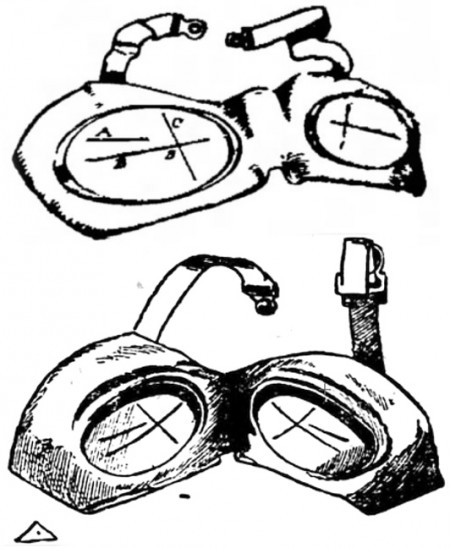Scientific, automotive, and news publications announced this marvel of modern design in 1907: Can you guess what they are?
 Yes, they’re goggles, but what doesn’t come across in these images is that the “lenses” are actually steel plates.
Yes, they’re goggles, but what doesn’t come across in these images is that the “lenses” are actually steel plates.
“Looked at from the distance of two or three feet away these plates appear to be solid and that by no means could the eyes see through them. But a closer inspection discloses (A, B, and C) in the smooth surface of the steel. They are in the form of a cross, with an additional shorter line above. These lines are cut through the steel plate, and when the goggles are properly adjusted to the eyes of the person wearing them can see in all directions through these narrow slits as well as if they were an ample surface of glass.”
It might seem counterinuitive — who can see through a tiny slit? — but what they’ve essentially created is a stenopaeic slit, a device used by opticians to detect astigmatism by filtering incoming light through what’s essentially an elongated pinhole camera. Based on the direction of the line, and whether the eyesight through the slit in one direction versus the other, can tell how malformed the lens is.
Technically, someone with good eyesight should be able to see through the slits fine — and the French optician who designed these lenses made a horizontal and a vertical one, to allow some eye movement. I don’t entirely get what the “A” line is for; my guess is for a modicum of peripheral vision. One thing these googles do not take into account is the movement of the eye when looking around; there may be some limited vision when just moving the eye from right to left, or up and down, but when doing so the pupil and iris are moving in orbit around the center of they eye, which doesn’t translate well compared to a flat surface. Wearing these googles means looking straight ahead for the best benefit, which I suppose is generally how driving is done. They may work OK, but I’d be hesitant to operate a moving vehicle with these in front of my face.
The technique found a resurgence during wartime as a means of protecting the eyes from shrapnel, since glass lenses pose a problem when struck by a small piece of metal at high speeds. Owing back to the science behind the stenopaeic slit’s optical origins, the style was refined over the years and is now the snake-oil vision-enhancing product called “pinhole glasses“. Pinhole glasses are believed to cure poor eyesight, for which there is little-to-no evidence. The original steel googles purported to cure “swelling and conjuctivitis”…which I can only assume is due to keeping stuff out of the eyeball, versus any special scientific principle.
The “snake oil” link above also warns that driving while wearing the pinhole glasses is a really, really bad idea. But, if you had tried these glassless goggles out, a hundred years ago, you’d already know that.